初中英语过去完成时语法精讲
完整版)初中英语过去完成时语法精讲

完整版)初中英语过去完成时语法精讲教学目标:本课将研究新词汇及其用法,掌握并应用过去完成时。
教学重点及难点:理解和应用过去完成时。
教学手段:使用多媒体课件。
教学过程:一、过去完成时的概念和结构特点过去完成时表示在过去某一时间或动作之前已经发生或完成了的动作,即“过去的过去(past-in-the-past)”。
构成:过去完成时由“助动词had+过去分词”构成,其中had通用于各种人称。
例如:They had already had ___.___ 10:00 this morning.二、过去完成时的判断依据1.由时间状语来判定各种时态都有特定的时间状语。
与过去完成时连用的时间状语有:By+过去的时间点。
例如:I had finished reading the novel by nine o'clock last night.By the end of+过去的时间点。
例如:We had learned over two thousand English words by the endof last term.Before+过去的时间点。
例如:They had ___.2.由“过去的过去”来判定过去完成时表示“过去的过去”,是指过去某一动作之前已经发生或完成的动作,即动作有先后关系,动作在前的用过去完成时,在后的用一般过去时。
这种用法常出现在:宾语从句中当宾语从句的主句为一般过去时,且从句的动作先于主句的动作时,从句要用过去完成时。
在told,said,knew,heard,thought等动词后的宾语从句。
例如:She said that she had seen the film before.状语从句中在时间、条件、原因、方式等状语从句中,主、从句的动作发生有先后关系,动作在前的,要用过去完成时,动作在后的要用一般过去时。
例如:When ___。
the train had already left。
精华版过去完成时讲解

精华版过去完成时讲解过去完成时是英语语法中的一个时态,用来表示在过去某一特定时间或动作之前已经发生或完成的动作。
在这篇文章中,我们将详细讲解过去完成时的用法和特点。
一、过去完成时的构成过去完成时的构成由“had + 过去分词”组成。
其中,“had”是过去完成时的助动词,根据主语的人称和数的变化进行变化,而过去分词则通常保持不变。
例如:1. I had finished my homework before my mom came home.我在我妈妈回家之前已经完成了我的作业。
2. They had already left when we arrived at the party.当我们到达派对时,他们已经离开了。
二、过去完成时的用法1. 表示在过去某一特定时间或动作之前已经发生或完成的动作。
例如:Before she arrived, he had already left.她到达之前,他已经离开了。
2. 表示过去某个时间点之前已经发生的动作。
By the time I got home, my sister had already eaten all the cake.当我到家时,我的妹妹已经把蛋糕都吃完了。
3. 在由时间状语从句引导的句子中,常用过去完成时表示在谓语动词所表示的动作之前发生的动作。
例如:She had finished her work before she went to bed.她上床睡觉前已经完成了她的工作。
4. 在条件句的结构中,过去完成时可以用来表示对过去情况的假设。
例如:If he had studied harder, he would have passed the exam.如果他学习更努力些,他就会通过考试。
三、过去完成时的注意事项1. 过去完成时经常与过去简单时连用,表示先后发生的两个动作。
例如:He had already left when I arrived.当我到达时,他已经离开了。
学会初中英语中的过去完成时用法

学会初中英语中的过去完成时用法在学习英语的过程中,过去完成时是一个相对复杂的时态。
它用于描述在过去某个时间点之前已经发生或完成的动作或状态。
本文将详细介绍初中英语中过去完成时的用法,并提供一些例句来帮助读者更好地理解。
一、过去完成时的构成过去完成时由"had"加上动词的过去分词构成。
例如:"had studied","had eaten"。
需要注意的是,过去完成时只能用于完成的动作或状态,而不能用于持续的动作或状态。
二、过去完成时的用法1. 表示在过去某个时间点之前已经发生或完成的动作或状态。
例句:- By the time I arrived at the cinema, the movie had already started.- He had finished his homework before his parents came back home.2. 用于过去的时间状语从句中,表示在过去某个时间点之前已经发生或完成的动作或状态。
例句:- I had already left when she called me.- They had gone to bed before the storm started.3. 用于虚拟条件句中,表示与过去事实相反的假设。
例句:- If I had known you were coming, I would have prepared dinner.- She would have passed the exam if she had studied harder.4. 用于间接引语中,表示过去某个时间点之前已经发生或完成的动作或状态。
例句:- He said that he had finished reading the book.- She told me that she had already seen the movie.三、过去完成时的注意事项1. 过去完成时通常与过去时态连用,用于描述过去发生的动作或状态。
过去完成时(详细讲解)

目 录
• 过去完成时基本概念 • 过去完成时用法详解 • 过去完成时与现在完成时对比 • 过去完成时常见错误及纠正 • 过去完成时典型例句分析 • 过去完成时在写作和口语中的应用
01 过去完成时基本概念
定义与构成
定义
过去完成时表示在过去某一时间 或动作之前已经发生或完成的动 作,即“过去的过去”。
主语 + had + not + 过去分词:表示主语在过去某一时间之前尚未完成的动作,即“过去 的过去”的否定形式。
主语 + had + just/already/ever/never等 + 过去分词:这些副词与过去完成时连用,表示 不同的时间概念和语气。例如,“just”表示“刚刚”,“already”表示“已经”, “ever”表示“曾经”,“never”表示“从未”。
02 过去完成时用法详解
表示过去某一时间前已完成的动作
动作发生在过去的过去
过去完成时表示在过去某一时间或动 作之前已经发生或完成的动作,即“ 过去的过去”。
强调动作的完成
过去完成时强调动作在过去某一时间 之前已经完成,不强调动作发生的具 体时间。
表示过去某一时间前已开始并持续到过去的动作
动作在过去某一时间前开始
过去完成时还可以在复合句中表 达“过去的过去”,即在过去某 个时间之前已经完成的动作。
在复合句中,过去完成时常用在 主句或从句中,表示一个动作在 另一个动作之前已经完成。
例如:By the time he was ten, he had learned to play the piano. 他十岁时就已经学会了弹钢 琴。
02
现在完成时的时间参照点是现在 ,表示从过去某个不确定的时间 开始一直持续到现在的动作或状 态。
初中英语过去完成时详细讲解

初中英语语法过去完成时详细讲解过去完成时是英语中一种表示过去某一时间点之前已经发生的动作或情况的时态。
它由"had + 过去分词"构成。
过去完成时的用法如下:1. 表示在过去某一时间点之前已经完成的动作:①She had already finished her homework when I arrived.(我到达时,她已经完成了作业。
)这里表示在我到达之前,她已经完成了作业。
②They had left before the concert started.(音乐会开始之前,他们已经离开了。
)这里表示在音乐会开始之前,他们已经离开了。
2. 表示在过去某一时间点之前持续的动作或状态:①He had been studying English for three years before he moved to England.(在他搬去英国之前,他已经学习英语三年了。
)这里表示在他搬去英国之前,他一直在学习英语。
需要注意的是,过去完成时强调的是过去某一时间点之前的动作或情况。
因此,常与过去的时间状语连用,如before、after等,以明确指定过去的时间点。
另外,过去完成时常与过去简单时连用,用于表示两个过去的动作或情况的先后顺序。
过去完成时的动作通常发生在过去简单时的动作之前。
例如:①She had finished her homework before she went to bed.(她在睡觉前已经完成了作业。
)②They had already left when I arrived at the party.(当我到达派对时,他们已经离开了。
)总结起来,过去完成时用于表示过去某一时间点之前已经发生的动作或情况,常与过去的时间状语连用,以明确指定过去的时间点。
同时,过去完成时通常与过去简单时连用,以表示两个过去的动作或情况的先后关系。
[全]初三英语语法重点-过去完成时-详解
![[全]初三英语语法重点-过去完成时-详解](https://img.taocdn.com/s3/m/3e7575e3a32d7375a517802f.png)
初三英语语法重点-过去完成时-详解过去完成时一、教材典句1.By the time l got outside, the bus had already left.当我出去时,公共汽车已经离开了。
2.By the time I walked into class, the teacher had started teaching already.当我走进教室时,老师已经开始讲课了。
仔细观察以上两句,不难发现时间状语从句都用了一般过去时态,主句都是发生在“过去的时间之前”,即过去的过去,应用过去完成时。
二、语法详解(一)过去完成时的定义及构成1.过去完成时定义:表示在过去某个时间或动作之前已经发生或完成了的动作,它表示动作所发生的时间是“过去的过去”。
2.过去完成时的构成过去完成时由“助动词had+动词的过去分词”构成(had用于各种人称和数)。
例如:She had arrived at the village before 8 o'clock last night.她在昨晚8点之前就到达了这个村庄。
(二)过去完成时的句式结构肯定句:had +过去分词否定句:hadn’t+过去分词一般疑问句:had 提前,放于句首(三)过去完成时的时间状语1.介词by (the end of)/ before+ 过去的时间例如:They had collected over 1,000 stamps by the end of last month.截至上个月末,他们已搜集了1000多张邮票。
2.与when, by the time, before, after 等引导的时间状语从句连用。
例如:When I got up this morning,my father had already gone to work. 今天早上我起床时,我的爸爸已经去上班了。
3.用于told, said, asked,heard,thought等动词的宾语从句中,从句的动作发生在主句动作之前。
初中的归纳与解析常见的过去完成时态及其用法解析

初中的归纳与解析常见的过去完成时态及其用法解析过去完成时是英语中一个重要的时态,它用来表示在过去某个时间点之前已经完成的动作或状态。
在初中英语学习中,学生需要掌握常见的过去完成时态以及正确运用。
本文将对常见的过去完成时态及其用法进行归纳与解析。
一、过去完成时态的构成过去完成时态由助动词“had”加上过去分词构成。
肯定句的结构为:主语 + had + 过去分词否定句的结构为:主语 + had not + 过去分词疑问句的结构为:Had + 主语 + 过去分词?二、过去完成时态的用法解析1. 表示过去某个时间点之前已经完成的动作或状态例如:He had already finished his homework before he went to bed.他在睡觉之前已经完成了作业。
2. 表示过去某个时间点之前已经发生了的结果或变化例如:When I arrived, they had already left.当我到达时,他们已经离开了。
3. 用于虚拟语气中的条件句的主句例如:If I had known the truth, I would have told you.如果我当时知道真相,我会告诉你的。
4. 在间接引语中表示间接引语的动作发生在说话之前例如:He said that he had finished reading the book.他说他已经读完了这本书。
三、常见的过去完成时态的词语与短语1. already表示“已经”,常与过去完成时连用。
例如:She had already left when I got there.当我到达时,她已经离开了。
2. before表示“在……之前”,常与过去完成时连用。
例如:He had finished his work before he left.他在离开之前已经完成了工作。
3. by the time表示“到……的时候”,常与过去完成时连用。
过去完成时用法详解

过去完成时用法详解1. 过去完成时简介过去完成时是英语中的一种时态,用来表示在过去某个时间点之前已经完成的动作或状态。
它通常由had(助动词“have”的过去式)和动词的过去分词构成。
2. 过去完成时的构成过去完成时的句子结构为had + 过去分词。
其中,had作为助动词,根据主语的人称和数的不同变化。
过去分词则是动词的过去式形式。
例如:- I had finished my homework before dinner.- She had already left when I arrived.3. 过去完成时的用法3.1 表示在过去某个时间点之前已经完成的动作过去完成时常用来表示在过去某个时间点之前已经完成的动作或状态。
这个时间点通常是用来作为对比的参照点。
例如:- He had studied English for five years before he moved to the United States.- They had already eaten when we arrived at the restaurant.3.2 表示过去的过程或顺序过去完成时也可以用来表示过去发生的一系列动作或事件中的先后顺序。
例如:- By the time I woke up, they had already left the house.- She had written the email, packed her bags, and left for the airport.3.3 与过去时态的区别过去完成时与过去时态有所区别。
过去完成时强调过去某个时间点之前完成的动作或状态,而过去时态则表示在过去的某个时间内发生的动作或情况。
例如:- He had finished his work. (过去完成时,表示在过去某个时间点之前完成)- He finished his work. (过去时态,表示在过去的某个时间内完成)4. 一些常见的信号词一些常见的信号词可以帮助我们判断何时使用过去完成时,包括:- before- after- by the time- when- already例如:- They had already left when I called them.- By the time she arrived, he had already left.5. 总结过去完成时是英语中一种常用的时态,用来表示在过去某个时间点之前已经完成的动作或状态。
初中英语语法之过去完成时详解

初中英语语法之过去完成时详解•相关推荐初中英语语法大全之过去完成时详解过去完成时是表示发生在过去的动作对过去晚些时候造成的影响或结果,或过去某一动作一直持续到过去晚些时候将来可能还要延续。
下面就是老师为同学们带来的对过去完成时的详细讲解,供同学们学习的参考。
总结过去完成时①表示发生在过去的动作对过去晚些时候造成的影响或结果②过去某一动作一直持续到过去晚些时候将来可能还要延续。
一、基本结构:主语+had+过去分词①肯定句:主语+had+过去分词.②否定句:主语+had+not+过去分词.③一般疑问句:Had+主语+过去分词? 肯定回答:Yes,主语+had. 否定回答: No,主语+had not .④特殊疑问句:特殊疑问词或词组+一般疑问句(Had+主语+过去分词)?二、基本用法1)表示在过去某一时刻或动作以前完成了的动作,也可以说过去的时间关于过去的动作。
即“过去的'过去”。
可以用by, before等介词短语或一个时间状语从句来表示,也可以用一个表示过去的动作来表示,还可能通过上下文来表示。
例如:By nine o’clock last night, we had gotten 200 pictures from the spaceship.到昨晚9点钟,我们已经收到200 张飞船发来的图片。
2)表示由过去的某一时刻开始,一直延续到过去另一时间的动作或状态,常和for, since构成的时间状语连用。
例如:I had been at the bus stop for 20 minutes when a bus finally came.当车来的时候,我在车站已等了20分钟。
He said he had worked in that factory since 1949.他说自从1949年以来他就在那家工厂工作。
3)一般说来,各种时态都有特定的时间状语。
与过去完成时连用的时间状语有:(1 )by + 过去的时间点。
中考英语考点梳理:过去完成时语法详解!

一. 过去完成时的概念与结构概念:表示在过去某一时间或动作之前已经发生或完成了的动作,即“过去的过去( past-in-the-past )”。
构成:“助动词 had + 过去分词”,其中 had 通用于各种人称。
They had already had breakfast before they arrived at the hotel.在到达旅馆之前,他们已经吃过了早饭。
She had finished writing the composition by 10:00 this morning. 今天早晨10点之前,她已经写完了作文。
二. 过去完成时的用法用法 1.表示一个动作或状态在过去某一时间或动作之前已经完成或结束,即发生在“过去的过去”。
例如:When I woke up, it had stopped raining.我醒来时,雨已经停了。
(雨停发生在醒来之前,即“过去的过去”)用法2. 表示某一动作或状态在过去某时之前已经开始,一直延续到这一过去时间,而且动作尚未结束,仍然有继续下去的可能。
例如:By the end of last year, he had worked in the factory for twenty years. 到去年年底为止,他已经在这个工厂工作了20年。
(到去年年底为止已工作了 20 年,还有继续进行下去的可能)三. 过去完成时的判断依据1. 由时间状语来判定一般说来,各种时态都有特定的时间状语。
与过去完成时连用的时间状语有:(1)by + 过去的时间点,例如:I had finished reading the novel by nine o'clock last night.到昨天晚上九点钟为止,我已经读完了这本小说。
(2)by the end of + 过去的时间点,例如:We had learned over two thousand English words by the end of last term.到上学期末为止,我们已经学了两千多单词。
过去完成时讲解全解课件

选择题练习
答案与解析: A. been on (正确)
选择题练习
• B. come on
ቤተ መጻሕፍቲ ባይዱ
填空题练习
• 填空题1: By the time I my homework, my parents dinner.
填空题练习
• 答案与解析:
• 填空1答案与解析: finished (正确) • 填空2答案与解析: had cooked (正确) • 解析: 句意是“当我完成作业的时候,我的父母已经做好了晚饭”。根据时间状语从
翻译练习
• 翻译1: 我已经完成了我的作业,现在我可以去看电影了。
翻译练习
01
答案与解析:
02
翻译: I have finished my homework, now I can go to the movies. (正确)
03
解析: 这句话的意思是“我已经完成了作业,现在我可以 去看电影了”。根据语境可知,这句话应该用现在完成时, 表示过去的某个动作对现在的影响。因此,正确的翻译是 “I have finished my homework, now I can go to the movies”。
在过去的某个时间点之前已经存在的状态
01
总结词
表示在过去的某个时间点之前已经存在的状态,这个状 态可能一直持续到该时间点。
03
02
详细描述
过去完成时也可以用来描述在过去的某个时间点之前已 经存在的状态,这个状态可能一直持续到该时间点,并 且可能对后续的状态或动作产生影响。
示例
He had known her for many years before they got married. (在他们结婚之前,他已经认识她很多年了。)
初中英语-过去完成时讲解ppt (共16张PPT)

The Past Perfect Tense 过去完成时
3. 常用的几种方式: 用介词by, before 等构成的时间短语.
We had learnt 20 English songs by the end of last month.
用连词when, before, after或者短语by the time 引导的时间状语从句.
already gone home.
THANK YOU
9.I h_a_d_n’_t_u_n_de_r_st_oo_d_____ the problem when class was over. (not understand)
口语练习
1.a.I got up. My brother was in the shower already. b.By the time I got up,my brother _h_a_d__g_o_t_t_e_n__ in the shower already.
The plane had taken off when I reached the airport. By the time I got up , my brother had left home.
1. 否定形式:had + not + 过去分词 (had not照样可缩写hadn't)。 2.一般疑问形式:had提到句首,
4. One of the men didn’t move, because he _h_a_d__b_r_o_k_e_n (break) his legs.
5.By yesterday evening he _ha_d__w_ri_t_te_n_______ that important letter.(write)
初中英语知识点归纳过去完成时的用法总结
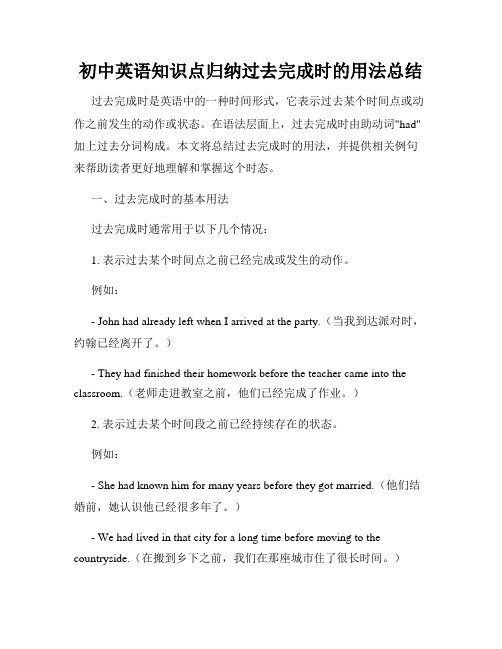
初中英语知识点归纳过去完成时的用法总结过去完成时是英语中的一种时间形式,它表示过去某个时间点或动作之前发生的动作或状态。
在语法层面上,过去完成时由助动词"had"加上过去分词构成。
本文将总结过去完成时的用法,并提供相关例句来帮助读者更好地理解和掌握这个时态。
一、过去完成时的基本用法过去完成时通常用于以下几个情况:1. 表示过去某个时间点之前已经完成或发生的动作。
例如:- John had already left when I arrived at the party.(当我到达派对时,约翰已经离开了。
)- They had finished their homework before the teacher came into the classroom.(老师走进教室之前,他们已经完成了作业。
)2. 表示过去某个时间段之前已经持续存在的状态。
例如:- She had known him for many years before they got married.(他们结婚前,她认识他已经很多年了。
)- We had lived in that city for a long time before moving to the countryside.(在搬到乡下之前,我们在那座城市住了很长时间。
)3. 在上下文中,过去完成时可以和表示过去的时间状语连用,以明确强调先后顺序。
例如:- She had already finished cooking dinner by the time her husband got home.(她的丈夫回家的时候,她已经做完饭了。
)二、过去完成时的特殊用法过去完成时还有一些特殊的用法需要注意:1. "wish"引导的虚拟语气句型过去完成时可以用于虚拟语气句型中,表示对过去的一种虚拟愿望或遗憾。
例如:- I wish I had studied harder when I was in school.(我希望我在学校时学习更努力。
精华版过去完成时讲解
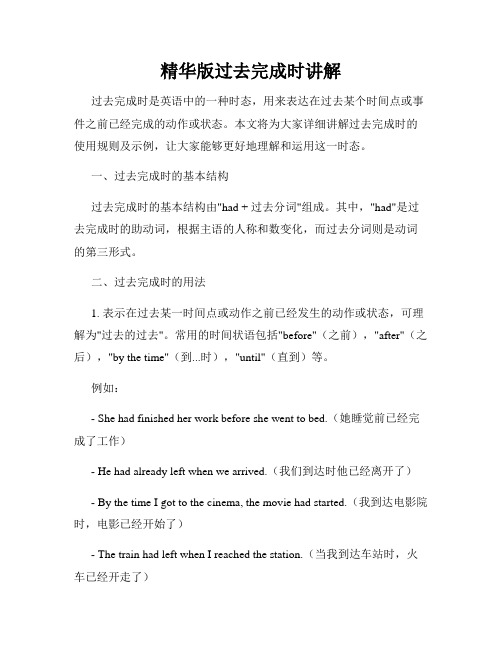
精华版过去完成时讲解过去完成时是英语中的一种时态,用来表达在过去某个时间点或事件之前已经完成的动作或状态。
本文将为大家详细讲解过去完成时的使用规则及示例,让大家能够更好地理解和运用这一时态。
一、过去完成时的基本结构过去完成时的基本结构由"had + 过去分词"组成。
其中,"had"是过去完成时的助动词,根据主语的人称和数变化,而过去分词则是动词的第三形式。
二、过去完成时的用法1. 表示在过去某一时间点或动作之前已经发生的动作或状态,可理解为"过去的过去"。
常用的时间状语包括"before"(之前),"after"(之后),"by the time"(到...时),"until"(直到)等。
例如:- She had finished her work before she went to bed.(她睡觉前已经完成了工作)- He had already left when we arrived.(我们到达时他已经离开了)- By the time I got to the cinema, the movie had started.(我到达电影院时,电影已经开始了)- The train had left when I reached the station.(当我到达车站时,火车已经开走了)2. 过去完成时也可用于虚拟语气,表示对过去某一动作的假设或想象。
例如:- If I had known the truth, I would not have made that mistake.(如果我当时知道真相,我就不会犯那个错误)- If he had studied harder, he would have passed the exam.(如果他学习更努力,他就能通过考试)3. 在间接引语中,当陈述句发生的时间先于引述动词的时间时,常使用过去完成时。
过去完成时详细讲解ppt课件

发生在去北京之前,因此第一个空应用过去完成时。
3.在told, said, knew, heard, thought等 动词引导的宾语从句中,一般用过去完成 时。
1. 她说她从来没有去过巴黎。
She said (that) she had never been to Paris.
选择填空
( c )1.--- “Did you see Tom at the party?”
---“No, Mary told me that he ___ by the time I got there.” A. left B. was leaving C. had left D. has left
by the end of last year. A. had learned B. have learned
C. learned D. will have learned 根据by短语中的last year得知, 正确选项为A。
三、主语+过去完成时+by the time引 导的从句(从句谓语动词为过去式)。 例如:
-- Sorry, I the piano for years.
A. don't play
B. wasn't playing
C. haven't played D. hadn't played
句意:…抱歉,我好多年都没有弹钢琴了。 现在完成时在此表示从好多年前算起到说 话的时候为止的(否定)状态的持续,所 以选C。
到目前为止我已经学会了3000个单词.
I have learned 3000 English words so far.
完整版)初中过去完成时讲解
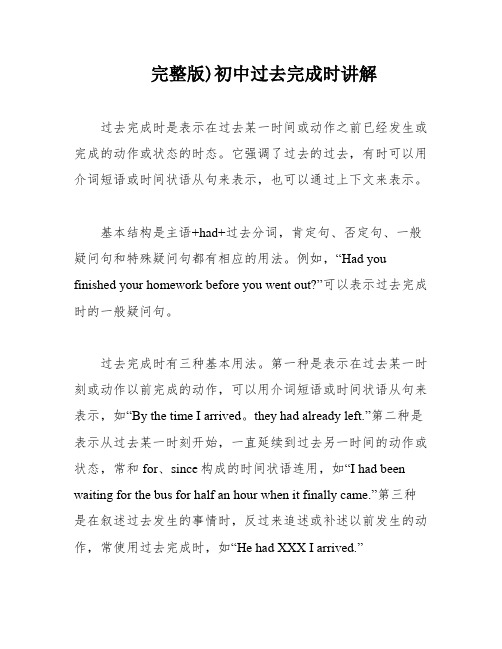
完整版)初中过去完成时讲解过去完成时是表示在过去某一时间或动作之前已经发生或完成的动作或状态的时态。
它强调了过去的过去,有时可以用介词短语或时间状语从句来表示,也可以通过上下文来表示。
基本结构是主语+had+过去分词,肯定句、否定句、一般疑问句和特殊疑问句都有相应的用法。
例如,“Had you finished your homework before you went out?”可以表示过去完成时的一般疑问句。
过去完成时有三种基本用法。
第一种是表示在过去某一时刻或动作以前完成的动作,可以用介词短语或时间状语从句来表示,如“By the time I arrived。
they had already left.”第二种是表示从过去某一时刻开始,一直延续到过去另一时间的动作或状态,常和for、since构成的时间状语连用,如“I had been waiting for the bus for half an hour when it finally came.”第三种是在叙述过去发生的事情时,反过来追述或补述以前发生的动作,常使用过去完成时,如“He had XXX I arrived.”在含有定语从句的主从复合句中,如果叙述的是过去的事,先发生的动作常用过去完成时,如“The book。
which I had read before。
was very interesting.”需要注意的是,过去完成时不应该和过去时混淆使用,因为它们的时间点不同。
过去完成时强调了过去的过去,而过去时则只是表示过去的动作或状态。
5) The past perfect tense is often used in the object clauses (or indirect speech) after verbs such as told。
said。
knew。
heard。
thought。
etc。
In this case。
初中过去完成时讲解
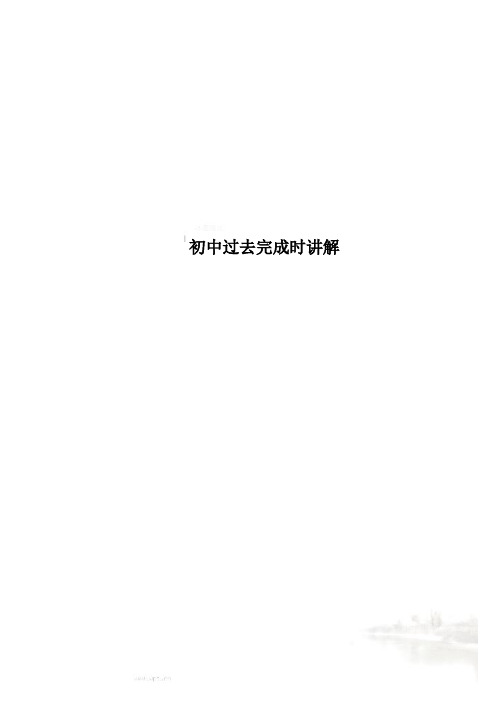
初中过去完成时讲解过去完成时定义过去完成时(past perfect)表示在过去某一时间或动作之前已经发生或完成了的动作或状态。
它表示句子中描述的动作发生在“过去的过去”。
基本结构主语+had+过去分词vpp.(done) ①肯定句:主语+had+过去分词.②否定句:主语+had+not+过去分词.③一般疑问句:Had+主语+过去分词? 肯定回答:Yes,主语+had.否定回答:No,主语+had not .④特殊疑问句:特殊疑问词或词组+一般疑问句(Had+主语+过去分词)?基本用法(1)表示在过去某一时刻或动作以前完成了的动作,也可以说过去的时间关于过去的动作。
即“过去的过去”。
可以用by, before,by the time +从句等介词短语或一个时间状语从句来表示,也可以用一个表示过去的动作来表示,还可能通过上下文来表示。
例如:By nine o’clock last night, we had got 200 pictures from the spacesh ip. 到昨晚9点钟,我们已经收到200 张飞船发来的图片。
(2)表示由过去的某一时刻开始,一直延续到过去另一时间的动作或状态,常和for, since构成的时间状语连用。
例如:I had been at the bus stop for 20 minutes when a b us finally came. 当车来的时候,我在车站已等了20分钟。
He said he had worked in that factory since 1949. 他说自从1949年以来他就在那家工厂工作。
(3)叙述过去发生的事情,在已叙述了过去发生的事情后,反过来追述或补述以前发生的动作时,常使用过去完成时。
例如:Mr. Smith died yesterday. He had been a good friend of mine.史密斯先生昨天去世了。
简单易懂过去完成时的详细解析

简单易懂过去完成时的详细解析过去完成时是英语中的一种时态,用来表示在过去某个时间之前已经发生或完成的动作或状态。
在使用过去完成时时,我们通常需要将动词的过去完成形式与适当的时间状语连用,以确保句子的意思清晰明了。
接下来将详细解析过去完成时的用法和相关注意事项。
一、过去完成时的构成1. 肯定句:主语 + had + 过去分词 + 其他成分(宾语、状语等)例如:I had finished my homework before my friend came over.(在朋友来之前我已经完成了作业。
)2. 否定句:主语 + had not(hadn't)+ 过去分词 + 其他成分例如:She hadn't heard the news before she met her colleagues.(在她遇见同事之前她没有听到这个消息。
)3. 疑问句:Had + 主语 + 过去分词 + 其他成分?例如:Had you visited that museum before it closed down?(在博物馆关闭之前你去过那个博物馆吗?)二、过去完成时的用法1. 表示在过去某一时间之前已经发生或完成的动作或状态。
例如:I had read the book by the time the movie was released.(电影上映之前我已经读完了这本书。
)2. 表示过去某一时间之前一直持续的状态。
例如:She had lived in that city for five years before moving to a new place.(她在那个城市住了五年之后搬到了新地方。
)3. 通常与表示过去的时间状语连用,以明确表示动作发生的先后顺序。
例如:The students had already left when the teacher arrived at school.(老师到校时学生们已经离开了。
【初中英语】初中英语过去完成时语法大全精讲
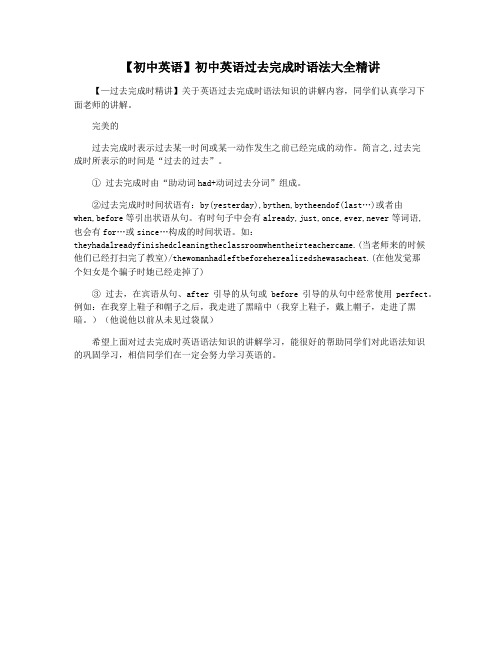
【初中英语】初中英语过去完成时语法大全精讲
【—过去完成时精讲】关于英语过去完成时语法知识的讲解内容,同学们认真学习下
面老师的讲解。
完美的
过去完成时表示过去某一时间或某一动作发生之前已经完成的动作。
简言之,过去完
成时所表示的时间是“过去的过去”。
① 过去完成时由“助动词had+动词过去分词”组成。
②过去完成时时间状语有:by(yesterday),bythen,bytheendof(last…)或者由
when,before等引出状语从句。
有时句子中会有already,just,once,ever,never等词语,
也会有for…或since…构成的时间状语。
如:theyhadalreadyfinishedcleaningtheclassroomwhentheirteachercame.(当老师来的时候
他们已经打扫完了教室)/thewomanhadleftbeforeherealizedshewasacheat.(在他发觉那
个妇女是个骗子时她已经走掉了)
③ 过去,在宾语从句、after引导的从句或before引导的从句中经常使用perfect。
例如:在我穿上鞋子和帽子之后,我走进了黑暗中(我穿上鞋子,戴上帽子,走进了黑暗。
)(他说他以前从未见过袋鼠)
希望上面对过去完成时英语语法知识的讲解学习,能很好的帮助同学们对此语法知识
的巩固学习,相信同学们在一定会努力学习英语的。
(完整word)初中过去完成时讲解

(完整word)初中过去完成时讲解过去完成时用法讲解一、概念:表示过去的过去,其构成是had +过去分词。
二、用法:1.表示某一动作在过去某一时刻之前已完成。
例如:He had gone to bed by 10:00 last night. (昨夜十点钟之前他已上床去睡了。
)2.与一般过去时搭配,表达某一动作在过去的动作发生时已完成。
例如:The train had started when I got to the XXX(当我到达车站时火车已开走了。
)The minute I saw a lady getting off the bus, I knew it was she, for I had seen her before. (我一看到正在下公共汽车的那位女士就知道是她,因为我以前看见过她。
)解说:使用曩昔完成时在简单句里表达某一举措在曩昔的某一时辰已完成时,该曩昔的时辰常以“by+曩昔工夫”的短语来表达。
例如下面的说法是不正确的:He had gone to bed at 10:00 last night.若是要说“at 10:00 last night”就必须用一般过去时“He went to bed...”。
请再观察下面的句子试比较:It XXX(误)It XXX.(正)或许你会说:“昨天下了雨,可是今天已放晴了,下雨已是过去的事,而且已经下完了,所以就用过去完成时……。
”这就是最令同学们对一般过去时和过去完成时感到混淆和困惑的。
实际上只要我们了解下面的两点原则就可以消除这种现象。
1.由过去的时间作状语来修饰动词的句子都使用一般过去时。
2.除非从谈话的先后关系和上下文关系对过去的动作完成的基准点可以确定以外,应该避免在简单句中使用过去完成时。
3、曩昔完成经经常使用的连词有:before, by, until, when, after, once, as soon as等。
例如:He said that he had learned some English before.By the time he was twelve, Edison had began to make a living by himself.Tom was disappointed that most of the guests had left when he arrived at the party.四、在什么情况下使用过去完成时?1.在told, said, knew, heard, XXX等动词引导的宾语从句中,一般用过去完成时。
- 1、下载文档前请自行甄别文档内容的完整性,平台不提供额外的编辑、内容补充、找答案等附加服务。
- 2、"仅部分预览"的文档,不可在线预览部分如存在完整性等问题,可反馈申请退款(可完整预览的文档不适用该条件!)。
- 3、如文档侵犯您的权益,请联系客服反馈,我们会尽快为您处理(人工客服工作时间:9:00-18:30)。
公开课教案Unit5 Grammar过去完成时
袁华峰08.10.29教学目标:
1、学习本课生词及用法
2、掌握并运用过去完成时
教学重点及难点:过去完成时的理解及运用
教学手段:多媒体课件
教学过程
一、过去完成时的概念与结构特点
概念:过去完成时表示在过去某一时间或动作之前已经发生或完成了的动作,即“过去的过去(past-in-the-past )”。
----|-------------------------- |-------------------------------|---------------------------->
那时以前那时现在
构成:过去完成时由“助动词had + 过去分词”构成,其中had 通用于各种人称。
They had already had breakfast before they arrived at the hotel.
She had finished writing the composition by 10 :00 this morning.
二、过去完成时的判断依据
1. 由时间状语来判定
一般说来,各种时态都有特定的时间状语。
与过去完成时连用的时间状语有:
( 1 )by + 过去的时间点。
如:
I had finished reading the novel by nine o'clock last night.
( 2 )by the end of + 过去的时间点。
如:
We had learned over two thousand English words by the end of last term. (3 )before + 过去的时间点。
如:
They had planted six hundred trees before last Wednesday.
2. 由“过去的过去”来判定。
过去完成时表示“过去的过去”,是指过去某一动作之前已经发生或完成的动作,即动作有先后关系,动作在前的用过去完成时,在后的用一般过去时。
这种用法常出现在:
( 1 )宾语从句中
当宾语从句的主句为一般过去时,且从句的动作先于主句的动作时,从句要用过去完成时。
在told, said, knew, heard, thought等动词后的宾语从句。
如:
She said that she had seen the film before.
(2 )状语从句中
在时间、条件、原因、方式等状语从句中,主、从句的动作发生有先后关系,动作在前的,要用过去完成时,动作在后的要用一般过去时。
如:
When I got to the station, the train had already left.
After he had finished his homework, he went to bed.
注意:before, after 引导的时间状语从句中,由于before 和after 本身已表达了动作的先后关系,若主、从句表示的动作紧密相连,则主、从句都用一般过去时。
如:Where did you study before you came here?
After he closed the door, he left the classroom.
(3)表示意向的动词,如hope, wish, expect, think, intend, mean, suppose等,用过去完成时表示"原本…,未能…"
We had hoped that you would come, but you didn't.
3. 根据上、下文来判定。
I met Wang Tao in the street yesterday. We hadn't seen each other since he w ent to Beijing.
三、过去完成时的主要用法
1. 过去完成时表示一个动作或状态在过去某一时间或动作之前已经完成或结束,即发生在“过去的过去”。
如:
When I woke up, it had stopped raining.
我醒来时,雨已经停了。
(主句的动作发生在“过去的过去”)
2. 过去完成时是一个相对的时态,表示的是“过去的过去”,只有和过去某一时间或某一动作相比较时才使用它。
如:
He told me that he had written a new book. (had written 发生在told 之前)
3. 过去完成时需要与一个表示过去的时间状语连用,它不能离开过去时间而独立存在。
此时多与already ,yet ,still ,just ,before ,never 等时间副词及by ,before ,until 等引导的短语或从句连用。
如:
Before she came to China, Grace had taught English in a middle school for ab out five years.
Peter had collected more than 300 Chinese stamps by the time he was ten.
4. 过去完成时表示某一动作或状态在过去某时之前已经开始,一直延续到这一过去时间,而且动作尚未结束,仍然有继续下去的可能。
如:
By the end of last year, he had worked in the factory for twenty years. (had worked 已有了20 年,还有继续进行下去的可能)
四、过去完成时与现在完成时的区别
现在完成时表示的动作发生在过去,但侧重对现在产生的结果或造成的影响,与现在有关,其结构为“助动词have (has) + 过去分词”;过去完成时则是一个相对的时态,它所表示的动作不仅发生在过去,更强调“过去的过去”,只有和过去某时或某动作相比较时,才用到它。
试比较:
I have learned 1000 English words so far.
到目前为止我已经学会了1000 个英语单词。
I had learned 1000 English words till then.
到那时为止我已经学会了1000 个英语单词。
—I'm sorry to keep you waiting. 对不起,让你久等了。
—Oh, not at all. I have been here only a few minutes.
没什么,我只等了几分钟。
(“等”的动作从过去某一时间点持续到现在)
—John returned home yesterday. 约翰昨天回到家的。
—Where had he been?
他去哪儿了?(答语中使用过去完成时是指约翰在returned home 之前去了哪些地方,即“过去的过去”)
五、过去完成时与一般过去时的区别
虽然这两种时态都表示过去发生的动作或存在的状态,但在使用时应注意以下几点:
1. 时间状语不同:过去完成时在时间上强调“过去的过去”;而一般过去时只强调过去某一特定的时间。
试比较:
They had arrived at the station by ten yesterday.
They arrived at the station at ten yesterday.
2. 在没有明确的过去时间状语作标志时,谓语动词动作发生的时间先后须依据上下文来判断:先发生的用过去完成时,后发生的则用一般过去时。
如:
She was very happy. Her whole family were pleased with her, too. She had just
won the first in the composition competition.
3. 当两个或两个以上接连发生的动作用and 或but 连接时,按时间顺序,只需用一般过去时来代替过去完成时;另外,在before ,after ,as soon as 引导的从句中,由于这些连词本身已经表示出时间的先后,因此也可以用过去时来代替过去完成时。
如:
He entered the room, turned on the light and read an evening paper.。
